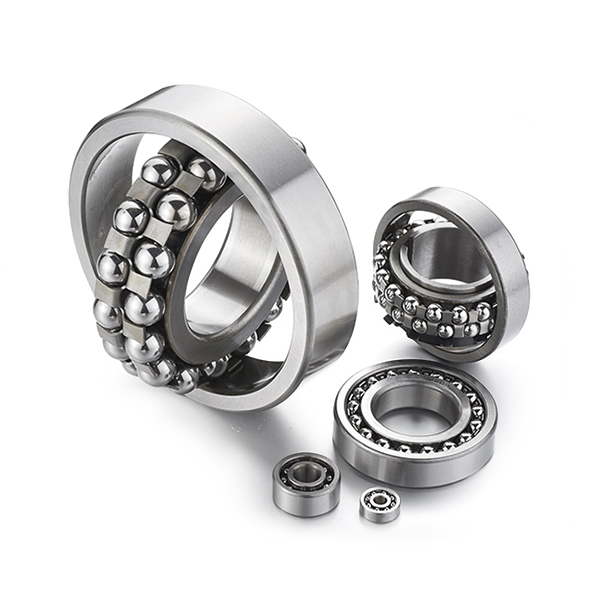The Importance of Self-Aligning Ball Bearing Maintenance
Self-aligning ball bearings are essential components commonly used in mechanical equipment, and their maintenance directly impacts their operating efficiency and service life. Regular maintenance can promptly detect bearing anomalies, prevent further failures, and ensure stable equipment operation. Maintenance not only includes cleaning, inspection, and adjustment, but also requires attention to the bearing's lubrication status. Proper maintenance measures can help reduce friction and wear during operation, avoiding downtime and increased repair costs caused by bearing damage.
Overview of Self-Aligning Ball Bearing Lubrication Methods
Lubrication is critical to ensuring the proper operation of self-aligning ball bearings. Lubrication methods primarily include oil and grease. Oil lubrication is suitable for high-speed or high-temperature conditions, effectively dissipating heat and reducing wear. Grease lubrication, on the other hand, is suitable for medium- and low-speed operation, offering longer maintenance intervals and ease of operation. Choosing the appropriate lubrication method requires careful consideration of factors such as the bearing's operating environment, load, and speed.
Lubricant Selection Requirements
Lubricant quality significantly impacts bearing performance. Select a lubricant with excellent oxidation resistance, high-temperature resistance, and rust resistance. Furthermore, the lubricant should be compatible with the bearing material and operating environment to avoid chemical reactions or performance degradation. In actual applications, the viscosity of the lubricant must be adjusted according to the operating temperature and speed to ensure the integrity of the lubricating film. Using an unsuitable lubricant may lead to premature bearing failure.
Lubrication Cycle and Refilling Method
The lubrication cycle should be determined based on a comprehensive assessment of the bearing's operating conditions, load conditions, and environmental impacts. For grease-lubricated bearings, grease should generally be refilled or replaced before the bearing reaches the recommended operating time. For oil-lubricated bearings, the oil level and quality should be regularly checked to ensure the oil is clean and sufficient. Lubricant can be refilled manually, with an automatic lubrication system, or through a circulating lubrication system. The selection should consider the equipment structure and ease of maintenance.

Bearing Cleaning and Maintenance Procedure
When maintaining self-aligning ball bearings, first clean the bearing and its mounting area to remove dust, dirt, and old lubricant residue. Use a suitable solvent during cleaning to avoid damaging seals. Next, inspect the bearing for abnormal wear, cracks, or corrosion. Only relubricate after confirming that there is no obvious damage. Finally, complete lubrication according to manufacturer's specifications or equipment operating conditions, and keep maintenance records for follow-up.
The Relationship Between Bearing Installation, Adjustment, and Maintenance
Self-aligning ball bearings have an automatic self-aligning function, but correct positioning during installation is still crucial to avoid abnormal bearing loads caused by improper installation. During maintenance, regular inspections should be performed to confirm that the bearing's axial and radial clearances are within the specified range. Improper adjustment can lead to inadequate lubrication or localized stress, increasing wear and temperature rise, and shortening bearing life. Maintenance personnel must be familiar with bearing structure and adjustment methods to ensure proper equipment operation.
The Impact of the Environment on Maintenance and Lubrication
The operating environment of bearings directly affects their maintenance frequency and lubrication requirements. Humid, dusty, or corrosive environments increase bearing contamination and corrosion, requiring enhanced cleaning and lubrication management. High-temperature environments require the use of high-temperature-resistant lubricants and shorter lubrication intervals. For outdoor or harsh environments, consider using self-aligning ball bearings with seals to reduce contaminant ingress and ensure effective lubrication.
Common Maintenance Problems and Preventative Measures
Common maintenance problems include underlubrication, overlubrication, lubricant contamination, and misaligned installation. Underlubrication can lead to metal-to-metal contact and increased wear, while overlubrication can cause temperature rise and seal damage. Lubricant contamination can affect lubrication performance and accelerate bearing damage. Mounting deviations can lead to uneven bearing loads. Preventing these problems requires standardized maintenance procedures, the use of appropriate tools, strict lubrication volume control, and regular inspections.
Technical Support and Standards for Maintenance and Lubrication
Self-aligning ball bearing maintenance and lubrication should be performed in accordance with relevant industry standards and manufacturer's technical data. National and international standards such as ISO and DIN set specific requirements for bearing maintenance, including lubricant type, addition amount, cycle time, and inspection methods. Effectively utilizing these technical support and standards can improve the scientific and effective nature of maintenance and reduce equipment failure rates.
Maintenance Records and Life Management
Maintaining detailed maintenance and lubrication records helps analyze bearing operating conditions and life trends. By recording lubrication times, lubricant types, maintenance issues, and their resolution, this can provide a reference for subsequent maintenance and optimize maintenance plans. Furthermore, incorporating technologies such as vibration monitoring and temperature monitoring allows for online monitoring of self-aligning ball bearings, improving preventative maintenance and extending service life.
Comparison of the Characteristics of Different Lubrication Methods
| Lubrication Method | Applicable Speed Range | Maintenance Interval | Main Advantages | Main Limitations |
|---|---|---|---|---|
| Oil Lubrication | High-speed and high-temperature conditions | Short | Good heat dissipation, reduces friction | Requires regular oil quality and level checks |
| Grease Lubrication | Medium and low-speed conditions | Long | Simple maintenance, good sealing performance | Not suitable for high temperature and high speed |
Copyright © Ningbo Demy (D&M) Bearings Co., Ltd. All Rights Reserved.

